Erin Centre Animal Hospital
3700 Eglinton Ave W, Unit #54
Mississauga, ON L5M 2R9, Canada
Helpful Tips for Dogs
-

Collecting a urine specimen from your dog – Male
Make sure that you use a clean plastic container. Your vet may provide you with one or you may use a clean margarine dish or something similar. A pie plate works best for female dogs. Keep in mind that a fresh specimen is best. Anything more than 12 hours old will not provide accurate results. If you can’t bring in the specimen within an hour of collecting it, make sure to place it in the refrigerator. Before collecting a specimen from a male dog, make sure you know which leg the dog prefers to lift, or if he prefers to squat. Instructions Wait for the dog to begin to urinate. Place the collection container into the stream of urine until an adequate amount has been collected. This is called a mid-stream sample. Place a lid on the container and bring it to your vet as soon as possible.
-
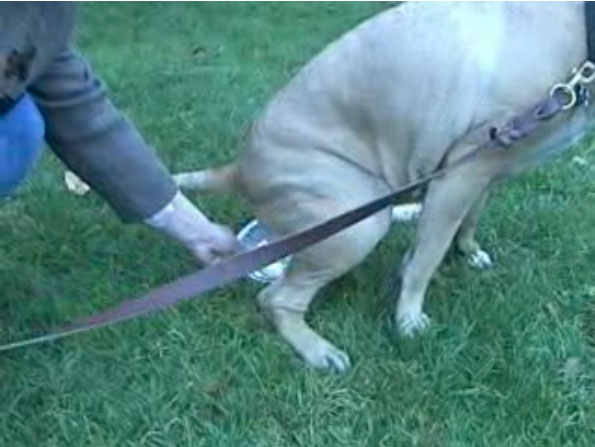
Collecting a urine specimen from your dog – Female
Make sure that you use a clean plastic container. Your vet may provide you with one or you may use a clean margarine dish or something similar. A pie plate works best for female dogs. Keep in mind that a fresh specimen is best. Anything more than 12 hours old will not provide accurate results. If you can’t bring in the specimen within an hour of collecting it, make sure to place it in the refrigerator. Instructions for Female Dog Approach the female dog slowly as she begins to squat. Place a shallow container under her after she has started to urinate. It is easiest to leave the container on the ground until she is finished. This is called a mid-stream sample. If you have used a pie plate, transfer the urine to a collection container with a lid and bring it to your vet as soon as possible. Some dogs will stop urinating when your approach them. If you experience difficulty in collecting a sample, contact your veterinarian.
-
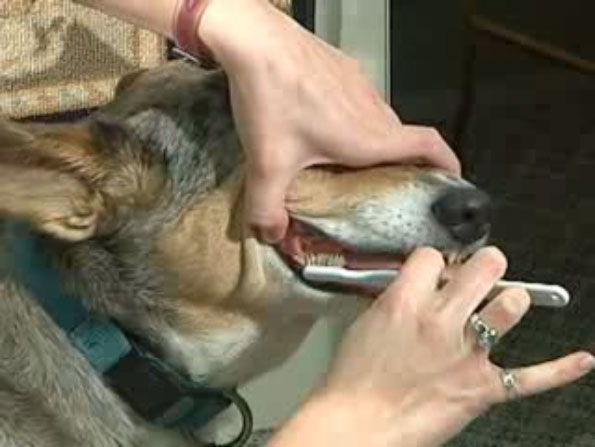
Brushing your dog’s teeth
Teaching your dog to accept brushing will take some training, but will be very beneficial to the dog once he is accustomed to the process. Daily brushing is most beneficial and will help to establish a routine for your pet, but brushing twice a week is acceptable if your schedule can’t accommodate daily brushing. Instructions Choose a quiet time and place to start the brushing. It is best to teach your dog to accept brushing while he or she is still a puppy. If you have an older dog, the process may take a little longer. First, call your dog to you in a friendly voice. Start by rubbing your finger or a soft cloth over the dog’s teeth in a back-and-forth motion. Once your dog is comfortable with this, you may try letting him or her taste a little bit of toothpaste from your finger. Pet toothpaste is recommended and is very appetizing to most pets. It may make brushing more enjoyable for them. Human toothpaste should not be used as it can result in the pet having an upset stomach. Once your dog has accepted the taste of the toothpaste, apply a small amount to a toothbrush and begin by raising your dog’s lip with your free hand, then brushing one or two cheek teeth in a straight back-and-forth motion. Try to hold the brush at a 45-degree angle to the tooth, with the bristles pointing toward the gumline. You will need to open the dog’s mouth slightly in order to reach the lower gumline. Work from the back teeth toward the midline of your dog’s mouth, then switch to the other side. Gradually work up to brushing all of the teeth (this will probably take several days). Make sure you reach the big teeth at the back…
-
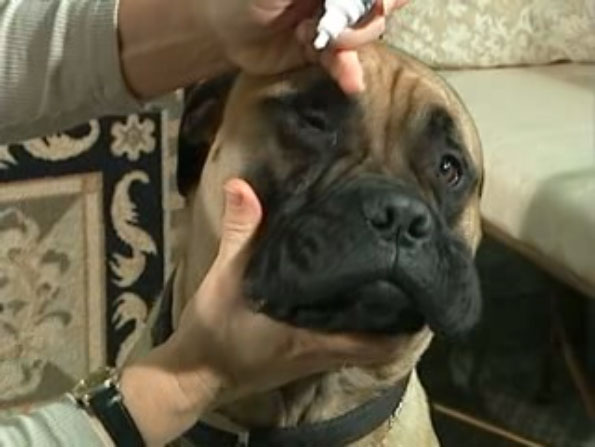
Administering eye drops to your dog
Make sure that you wash your hands both before and after administering the medication to prevent the spread of infection. If your dog’s eye is painful, you may need to have someone assist you with restraining or you may need to apply a muzzle. Instructions Make sure you have carefully read the label and understand the dosing instructions. Hold the bottle using your thumb and index finger. You may want to rest this hand on the top of the dog’s head to help stabilize your hand. With your other hand, use your thumb to pull down the lower eyelid. Place your remaining fingers under the dog’s jaw to support the head. The lower eyelid acts as a pouch to receive the drops. Hold the bottle close to the eye but make sure you DO NOT touch the eye’s surface. Squeeze the prescribed number of drops onto the eyeball, aiming for the center of the eye, and then release the head. The dog will blink, spreading the medication over the surface of the eye. Make sure you give your dog plenty of praise throughout the procedure and offer a treat when you are finished.
-
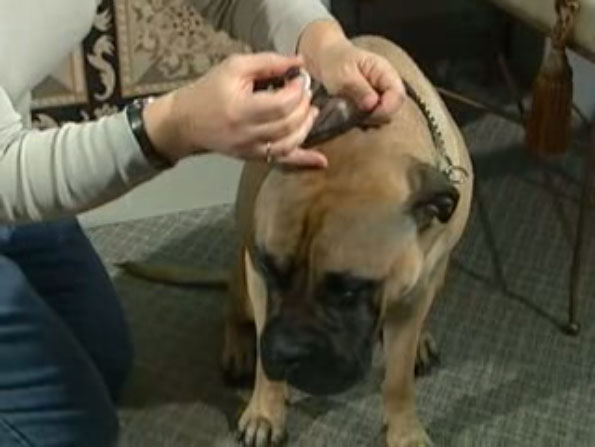
Administering ear drops to your dog
Remember that the ear may be very painful and that even a passive dog may respond by biting. You may need to muzzle the dog for this procedure. Instructions Click on the “video” button to watch a demonstration or read the steps that follow. Warm the medication by standing the bottle in a bowl of warm water for a few minutes. Make sure you have carefully read the label and understand the dosing instructions. Draw up the liquid into the dropper. Gently pull the ear flap straight up using your other hand. Apply the prescribed number of drops into the ear canal while continuing to keep the ear flap elevated. Rub the ear against the dog’s head in a circular motion. Be cautious and gentle. The dog may not allow you to do this. Release the ear and let your dog shake its head. If the medication contains a wax solvent, debris will be dissolved so it can be shaken out. Make sure you give your dog plenty of praise throughout the procedure and offer a treat after giving the medication.
-
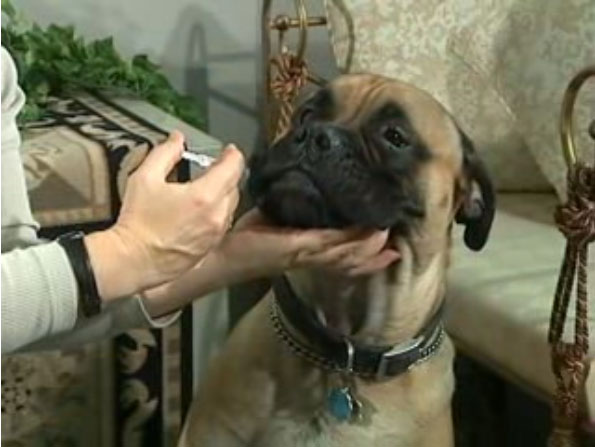
Giving liquid medication to your dog
The easiest way to give your dog a liquid medication is to mix it with some canned food. To ensure that the medication is actually taken, it is best to give a small amount of food that the dog is certain to eat rather than a large portion that the dog may not complete. Some dogs may be unwilling to eat the food or may have dietary restrictions that prevent you from using this technique. If this is the case, you will need to administer the medication directly into your dog’s mouth.
-
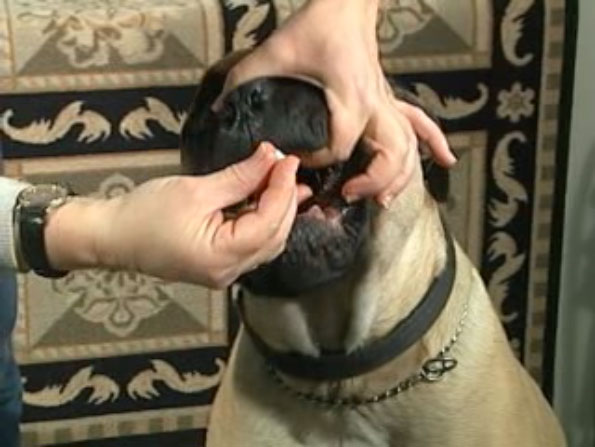
Giving your dog a pill
Instructions Grease the pill with a very small amount of margarine or butter so that it doesn’t stick in the pets mouth or throat. Hold the pill between your thumb and index finger (use your dominant hand – for example, if you are right handed, use your right hand). Gently grasp your dog’s muzzle from above with your other hand, by placing your thumb on one side and your fingers on the other side behind the canine teeth. Once you have a firm but gentle hold tilt your dog’s head toward the ceiling. The lower jaw will usually drop. If not, open the mouth by placing the last two fingers of your hand holding the pill between the two lower canine teeth. Quickly place the pill as far back over the tongue as possible. The pill is most likely to be swallowed if you place it beyond the hump of the tongue at the back of the mouth. Try not to place your hand too far back to avoid stimulating a gag reflex. Close the dog’s mouth and hold it closed while you return the head to a normal position. Gently rub the dog’s nose or throat, or blow lightly on the dog’s nose. This should stimulate swallowing. Make sure that you have carefully read the label and understand the dosing instructions. The easiest way to give a pill is to hide it in a small amount of canned dog food, peanut butter or cheez whiz. Some dogs may spit out the pill, so it is important to monitor this activity. If your dog persists in spitting out the pills or if dietary restrictions prevent you from hiding the pills in an appealing treat, you will need to administer the pill directly into the dog’s mouth. The dog will be…
